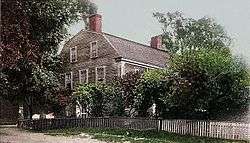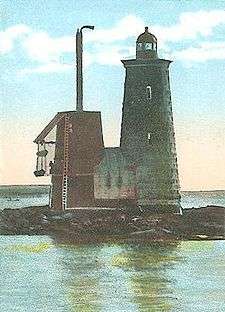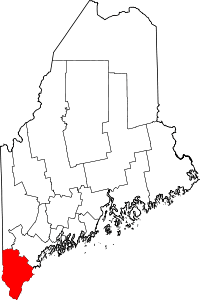Kittery, Maine
Kittery is a town in York County, Maine, United States. Home to the Portsmouth Naval Shipyard on Seavey's Island, Kittery includes Badger's Island, the seaside district of Kittery Point, and part of the Isles of Shoals. The town is a tourist destination known for its many outlet stores. It is the southernmost town in Maine.
Kittery, Maine | |
|---|---|
 Old Block House at Fort McClary (c. 1908) | |
 Seal | |
| Motto(s): Gateway to Maine | |
 Kittery Location within the state of Maine | |
| Coordinates: 43°5′35″N 70°43′41″W | |
| Country | |
| State | |
| County | York |
| Settled | 1632 |
| Incorporated | 1647 |
| Government | |
| • Assessor | Bruce Kerns |
| Area | |
| • Total | 75.30 sq mi (195.03 km2) |
| • Land | 17.78 sq mi (46.05 km2) |
| • Water | 57.52 sq mi (148.98 km2) |
| Elevation | 23 ft (7 m) |
| Population | |
| • Total | 9,490 |
| • Estimate (2012[3]) | 10,072 |
| • Density | 533.7/sq mi (206.1/km2) |
| Time zone | UTC−5 (Eastern (EST)) |
| • Summer (DST) | UTC−4 (EDT) |
| ZIP Code | 03904 |
| Area code(s) | 207 |
| FIPS code | 23-37270 |
| GNIS feature ID | 0582544 |
| Website | www.kitteryme.gov |
Kittery is part of the Portland–South Portland–Biddeford, Maine metropolitan statistical area. The town's population was 9,490 at the 2010 census. Kittery may be the namesake of William Billings' 1783 anthem "Kittery", which is printed in the Shenandoah Harmony and Missouri Harmony shape note tunebooks, but because the song was published after the incorporation of the town, this is debated.
History
English settlement around the natural harbor of the Piscataqua River estuary began about 1623. By 1632 it was protected by Fort William and Mary on today's New Hampshire side of the river; in 1689 defensive works that later became Fort McClary in Kittery Point were added on today's Maine side to the north.
Kittery was incorporated in 1647, staking a claim as the "oldest incorporated town in Maine."[4] It was named after the birthplace of a founder, Alexander Shapleigh, from his manor of Kittery Court at Kingswear in Devon, England. Shapleigh arrived in 1635 aboard the ship Benediction, which he co-owned with another prominent settler, Captain Francis Champernowne,[5] a cousin of Sir Ferdinando Gorges, lord proprietor of Maine.[6] Together with the Pepperrell family, they established fisheries offshore at the Isles of Shoals, where fish were caught, salted, and exported back to Europe. Other pioneers were hunters, trappers, and workers of the region's abundant timber. The settlement at the mouth of the Piscataqua River was protected by Fort McClary.[7]
Thomas Spencer, Esquire, immigrant from Gloucestershire, England, is also a notable settler of Kittery with his wife Patience Chadbourne. Their story is included in "The Maine Spencers: a history and genealogy, with mention of many associated families."
Kittery originally extended from the Atlantic Ocean inland up the Salmon Falls River, including the present-day towns of Eliot, South Berwick, Berwick and North Berwick. Located opposite Portsmouth, New Hampshire, the town developed into a center for trade and shipbuilding. After the death of Gorges, Maine in 1652 became part of the Massachusetts Bay Colony. Francis Small was a pioneer resident of Kittery, and operated a trading post near the confluence of the Ossipee River and Saco River. Here major Indian trails converged—the Sokokis Trail (now Route 5), the Ossipee Trail (now Route 25), and the Pequawket Trail (now Route 113) -- a location conducive towards lucrative fur trade with Indians, but also with risks of living isolated in the wilderness.[8] Small became the largest property owner in the history of Maine, and became known as "the great landowner".[9][10]
In 1663, John Josselyn would write: "Towns there are, are not many in this province. Kittery, situated not far from Passacataway (Portsmouth), is the most populous." [11]
In 1705, during Queen Anne's War tribes of the Wabanaki Confederacy raided the town killing six citizens and taking five prisoners.[12]
During the Revolution, the first vessels of the U.S. Navy were constructed on Badger's Island, including the 1777 USS Ranger commanded by John Paul Jones. The Portsmouth Naval Shipyard, the nation's first federal navy yard, was established in 1800 on Fernald's Island. It connects to the mainland by two bridges. The facility rebuilt the USS Constitution, and built the Civil War USS Kearsarge. Seavey's Island was annexed and became site of the now defunct Portsmouth Naval Prison.[13]
Kittery has some fine early architecture, including the Sir William Pepperrell House, built in 1733, and the Lady Pepperrell House, built in 1760. The John Bray House, built in 1662, is believed to be the oldest surviving house in Maine. Located at the John Paul Jones Memorial Park on U.S. 1 is the Maine Sailors' and Soldiers' Memorial by Bashka Paeff. Further northeast up the road, the town has developed factory outlet shopping, very popular with tourists. Kittery Point is home to Seapoint Beach and Fort Foster Park, originally a harbor defense. In 1905, The Treaty of Portsmouth formally ending the Russo-Japanese War, was signed at the shipyard. In 1996, the movie Thinner, based on the 1984 Stephen King novel, was filmed in Kittery. The Saturday morning cartoon DinoSquad is based in Kittery/Kittery Point.
 Pepperrell House c. 1905
Pepperrell House c. 1905 Government St. c. 1910
Government St. c. 1910 Navy Yard Bridge c. 1908
Navy Yard Bridge c. 1908 Shipyard dry dock c. 1908
Shipyard dry dock c. 1908
Geography
According to the United States Census Bureau, the town has a total area of 75.30 square miles (195.03 km2), of which, 17.78 square miles (46.05 km2) of it is land and 57.52 square miles (148.98 km2) is water.[1] Situated beside the Gulf of Maine and Atlantic Ocean, Kittery is drained by Spruce Creek, Spinney Creek, Chauncey Creek and the Piscataqua River.
The town is crossed by Interstate 95, U.S. Route 1, Maine State Route 101, Maine State Route 103, and Maine State Route 236.
Demographics
- See also Kittery (CDP), Maine and Kittery Point, Maine for village demographics
| Historical population | |||
|---|---|---|---|
| Census | Pop. | %± | |
| 1790 | 3,259 | — | |
| 1800 | 3,114 | −4.4% | |
| 1810 | 2,019 | −35.2% | |
| 1820 | 1,886 | −6.6% | |
| 1830 | 2,202 | 16.8% | |
| 1840 | 2,435 | 10.6% | |
| 1850 | 2,706 | 11.1% | |
| 1860 | 2,974 | 9.9% | |
| 1870 | 3,333 | 12.1% | |
| 1880 | 3,230 | −3.1% | |
| 1890 | 2,864 | −11.3% | |
| 1900 | 2,872 | 0.3% | |
| 1910 | 3,533 | 23.0% | |
| 1920 | 4,763 | 34.8% | |
| 1930 | 4,400 | −7.6% | |
| 1940 | 5,374 | 22.1% | |
| 1950 | 8,380 | 55.9% | |
| 1960 | 10,689 | 27.6% | |
| 1970 | 11,028 | 3.2% | |
| 1980 | 9,314 | −15.5% | |
| 1990 | 9,372 | 0.6% | |
| 2000 | 9,543 | 1.8% | |
| 2010 | 9,490 | −0.6% | |
| Est. 2014 | 9,649 | [14] | 1.7% |
| [15][16][17] | |||
2010 census
As of the census[2] of 2010, there were 9,490 people, 4,302 households, and 2,488 families living in the town. The population density was 533.7 inhabitants per square mile (206.1/km2). There were 4,942 housing units at an average density of 278.0 per square mile (107.3/km2). The racial makeup of the town was 97.1% White, 0.01% African American, 0.1% Native American, 1.1% Asian, 0.1% Pacific Islander, 0.5% from other races, and 1.5% from two or more races. Hispanic or Latino of any race were 2.6% of the population.
There were 4,302 households, of which 23.5% had children under the age of 18 living with them, 46.3% were married couples living together, 7.9% had a female householder with no husband present, 3.6% had a male householder with no wife present, and 42.2% were non-families. 32.8% of all households were made up of individuals, and 12.6% had someone living alone who was 65 years of age or older. The average household size was 2.17 and the average family size was 2.77.
The median age in the town was 43.2 years. 18.2% of residents were under the age of 18; 7.8% were between the ages of 18 and 24; 26% were from 25 to 44; 30.3% were from 45 to 64; and 17.7% were 65 years of age or older. The gender makeup of the town was 48.3% male and 51.7% female.
2000 census
As of the census[18] of 2000, there were 9,543 people, 4,078 households, and 2,528 families living in the town. The population density was 535.5 people per square mile (206.8/km2). There were 4,375 housing units at an average density of 245.5 per square mile (94.8/km2). The racial makeup of the town was 95.98% White, 1.78% Black or African American, 0.18% Native American, 0.65% Asian, 0.02% Pacific Islander, 0.45% from other races, and 0.94% from two or more races. Hispanic or Latino of any race were 1.50% of the population.
There were 4,078 households, out of which 27.7% had children under the age of 18 living with them, 50.1% were married couples living together, 8.6% had a female householder with no husband present, and 38.0% were non-families. 29.4% of all households were made up of individuals, and 10.6% had someone living alone who was 65 years of age or older. The average household size was 2.29 and the average family size was 2.86.
In the town, the population was spread out, with 21.9% under the age of 18, 7.4% from 18 to 24, 30.7% from 25 to 44, 24.8% from 45 to 64, and 15.2% who were 65 years of age or older. The median age was 39 years. For every 100 females, there were 94.8 males. For every 100 females age 18 and over, there were 92.1 males.
The median income for a household in the town was $52,200, and the median income for a family was $53,343. Males had a median income of $37,096 versus $29,850 for females. The per capita income for the town was $24,153. About 5.7% of families and 7.6% of the population were below the poverty line, including 11.9% of those under age 18 and 6.6% of those age 65 or over.
Sites of interest
- Fort Foster Park
- Fort McClary State Historic Site
- John Paul Jones Memorial Park
Education
Kittery is home to Robert William Traip Academy (9-12), a formerly private, preparatory school which became public and town-run in 1967.
Along with, Horace Mitchell Primary School (K-3) and Shapleigh School (4-8).
Notable people

- Jess Abbott, guitarist of the band Now, Now
- William Badger, master shipbuilder
- Devin Beliveau, state representative
- John Haley Bellamy, woodcarver, folk artist
- George Berry, captain, shipbuilder
- Dennis C. Blair, admiral
- Scott Brown, ambassador, senator from Massachusetts (2010–2013)
- Tunis Craven, naval officer
- Shem Drowne, metalworker, creator of Boston's Grasshopper Weathervane
- Elisha T. Gardner, Wisconsin politician, lawyer
- William Dean Howells, writer, magazine editor
- Sandi Jackson, Chicago city alderman
- Kenneth F. Lemont, state legislator
- Jeremiah O'Brien, naval officer
- John O'Hurley, television actor
- Sir William Pepperrell, merchant, soldier
- Joseph T. Palastra Jr., U.S. Army General
- Arthur Shawcross, serial killer
- Hunt Slonem, artist
- Francis Small, trader and landowner
- Celia Thaxter, poet
- John Treworgie, last proprietary governor of Newfoundland
- Walter Wheeler, state representative
- William Whipple, signer of the Declaration of Independence
References
- "US Gazetteer files 2010". United States Census Bureau. Archived from the original on 2012-12-20. Retrieved 2012-12-16.
- "U.S. Census website". United States Census Bureau. Retrieved 2012-12-16.
- "Population Estimates". United States Census Bureau. Archived from the original on 2013-06-17. Retrieved 2013-07-06.
- Town of Kittery Maine, Chapter One The History of Kittery. Retrieved May 1, 2016.
- The Champernownes were a prominent shipping family from Devon in England's West Country, having been a fixture in mercantile and social scene there for generations. Kat Ashley, née Champernowne, was a close friend and governess to Queen Elizabeth I. Her niece Catherine Champernowne was the mother of Sir Walter Raleigh and Sir Humphrey Gilbert. At the heart of the family dynastic influence lay Sir Arthur Champernowne, who served as Vice-Admiral of the West, while residing at Dartington Hall in Devon.
- "Sir Ferdinando Gorges and His Province of Maine".
- Coolidge, Austin J.; John B. Mansfield (1859). A History and Description of New England. Boston, Massachusetts: A.J. Coolidge. pp. 182–185.
coolidge mansfield history description new england 1859.
- "About Cornish Maine and CAB – Cornish Association of Businesses". Archived from the original on 2010-11-21.
- Descendants of Edward Small Archived 2011-07-11 at the Wayback Machine
- Sullivan, Gov. James, The History of the District of Maine, I. Thomas and E. T. Andrews, Publishers, Boston, MA, 1795.
- Varney, George J. (1886), Gazetteer of the state of Maine. Kittery, Boston: Russell
- "The border wars of New England, commonly called King William's and Queen Anne's wars".
- "Portsmouth Naval Shipyard (NSY)".
- "Annual Estimates of the Resident Population for Incorporated Places: April 1, 2010 to July 1, 2014". Archived from the original on May 23, 2015. Retrieved June 4, 2015.
- https://www.census.gov/population/www/censusdata/cencounts/files/me190090.txt
- Data Access and Dissemination Systems (DADS). "U.S. Census website".
- University of Virginia Library. Mapserver.lib.virginia.edu. Retrieved on 2014-05-24.
- "U.S. Census website". United States Census Bureau. Retrieved 2008-01-31.
Further reading
- Stackpole, Everett S. Old Kittery and its Families. Published 1903. Full image at books.google
- History of Whaleback Light
- Seacoast Forts of Portsmouth Harbor from American Forts Network
External links
| Wikimedia Commons has media related to Kittery, Maine. |
